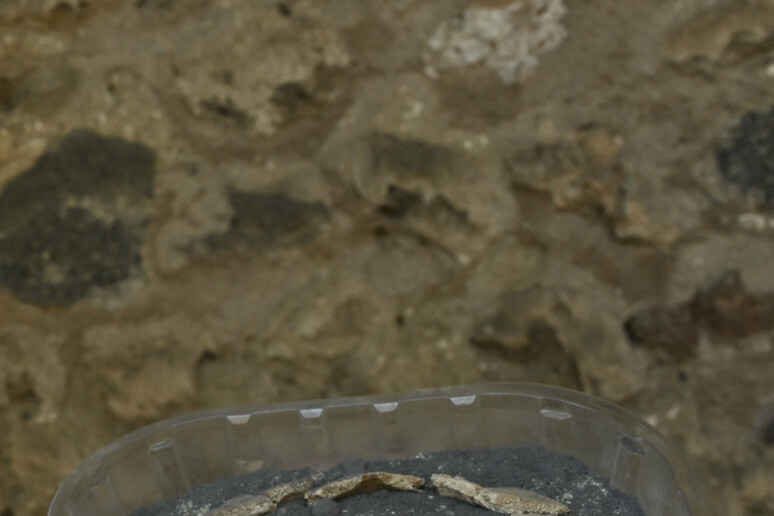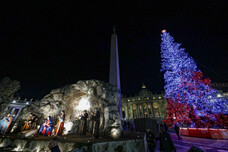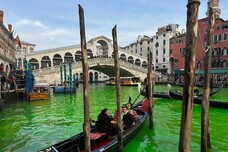(By Silvia Lambertucci).
The shell almost unscathed, the head intact like the tail and
one of the feet. A small land tortoise, incredibly preserved
with its never-laid egg, is the latest surprise from Pompeii
that ANSA can describe in a sneak preview.
The archaeologists found it at a depth of half a metre under the
clay floor of a shop in the central Via dell'Abbondanza, where a
joint survey by the Oriental University of Naples, Berlin's
Freie Universitat and Oxford University is probing the remains
of a luxury home that was demolished after the earthquake of 62
AD and incorporated into the Stabian baths.
"Pompeii is a trove of history that fascinates the world,"
applauds Culture Minister Dario Franceschini.
It is an important find, explains the director of the
archaeological park, Gabriel Zuchtriegel, "which opens a window
on the last years in the life of the city", those following the
earthquake, "in which the whole of Pompeii was turned into one
big pulsating building site".
In this context, the director says, the town's ecosystem
changes, with wild animals finding a place in the buildings
going up or in shops like this, right in the heart of the city.
The tortoise evidently got into the store-cum-tavern "and there,
in a sheltered corner, it dug a nest to lay its egg in," says
anthropologist Valeria Amoretti, "something which did not
succeed and which may have caused its death".
The research will now continue in the laboratory, but meanwhile,
with the help, in the field, of students from the Neapolitan
university, the floors and decorations of the magnificent house
that originally occupied that space are returning to the light.
It is a dwelling of great prestige, say Marco Giglio of the
Oriental University and Monika Trumper of the university in
Berlin, which stretched for over 900 square metres with its
grand rooms and courtyards in a very central quarter of the
city.
It also features carpets of mosaics which in their complexity
and beauty, the professors say, can be compared to those of the
Villa of Mysteries or the House of Ceres, made precious by
refined and rare drawings and designs that in some cases
reproduce the wonders of Roman architecture, like the long
aqueduct that appears on the floor of the tablinium.
It is a marvel that the excavations of the last few weeks have
restored, also through fragments of what it was: plinths in
multi-coloured marble, a small, beautiful terracotta mask, and
even a painted shell that must have been shown off to its best
in some niche.
Only two fragments remain of the walls, sadly, small but very
impressive, with elaborate and richly coloured wall paintings in
the II style, in fashion in the first century AD. And that is
not all: in another corner of shop where the tortoise was found,
in the spot where the entrance of the domus must have originally
been, the archaeologists have found a votive trench, practically
a hole dug on the occasion of the foundation of the house, with
burned wooden remains and auspicious and placatory offerings for
the gods.
This was a very widespread practice in the Roman world, says
Giglio, but which it has not been hitherto possible to study
greatly in Pompeii. Among the charred remains there was also the
broken olla that had contained the offerings, together with a
small lamp. And it is from this, which dates back to the first
century BC, Giglio explains, "that we got proof that this house
was actually built in the first half of the first century BC".
Perhaps immediately after 80 BC, he adds, when after Sulla's
siege the city suffered the indignity of being turned into a
Roman colony.
There remains the mystery of who may have been its wealthy
owner: perhaps a Roman higher-up, a high-ranking officer in the
army or perhaps a Pompeian man who had supported Sulla?
The professor does not come down on one side of the argument or
another. "It was certainly an eminent figure in Pompeian life",
he replies. "For now we cannot say more, let us hope that we
will learn more in the next campaign of excavations, in 2023".
As it also remains to be understood why, 150 years after its
construction, this splendid abode was razed to the ground. In
this case, too, we can only grasp at hypotheses: perhaps the
earthquake had damaged it so much that it was too costly and
inconvenient to restructure it; or perhaps, as has been
documented in other cases in Pompeii, the fear endured in the
earthquake persuaded the owners to move to a location they
deemed safer. Or perhaps the family that built it may have
fallen lower down the rungs of society in the meantime. What is
certain at the moment is that all that luxury, with property
market prices having plummeted after the quake, passed into the
ownership of the city administration which put it at the
disposal of the baths in which it was decided to invest a lot of
money, building a big new bathing area equipped with running
water, scenes of water nymphs, and ultra-modern and
super-technological amenities for the time.
Monika Trumper, the archaeologist who is an expert in baths and
who heads the German group, has no doubts: "Here there was
non-stop building and there was confidence in the future. "No
one had any idea whatsoever of the catastrophe which would
strike down on Pompeii just a short while later"
ALL RIGHTS RESERVED © Copyright ANSA











